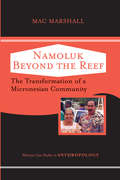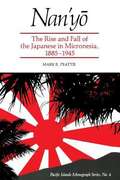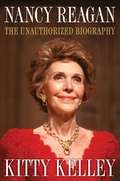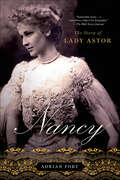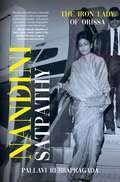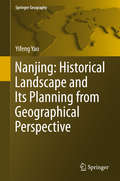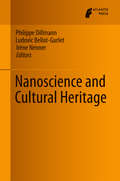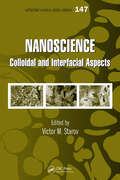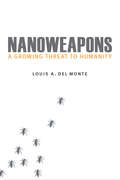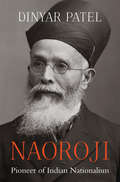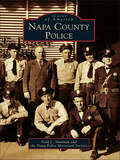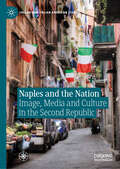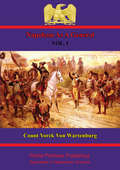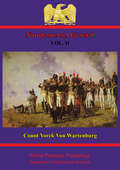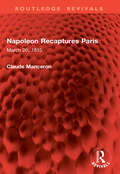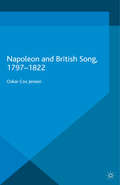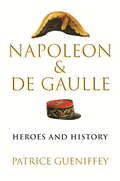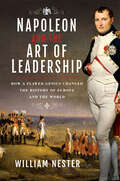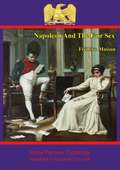- Table View
- List View
Namoluk Beyond The Reef: The Transformation Of A Micronesian Community (Westview Case Studies In Anthropology)
by Mac MarshallThis case study examines emigrants from Namoluk Atoll in the Eastern Caroline Islands of Micronesia, in the Western Pacific. Most members of the Namoluk community (chon Namoluk) do not currently live there - some 60% of them have moved to Chuuk, Guam, or the mainland US (such as Honolulu, Hawai'i or Eureka, California). The question is how (and why) those expatriates continue to think of themselves as chon Namoluk, and behave accordingly, despite being a far-flung network of people, with inevitable erosions of shared language and culture.
Nan'yo: The Rise and Fall of the Japanese in Micronesia, 1885-1945 (Pacific Islands Monograph Series, No. #4)
by Mark R. PeattieJapan was ejected from portions of Micronesia at the end of World War II, yet a strong Japanese presence has continued. Older Islanders have memories of the Japanese period, and some still speak textbook Japanese
Nancy Reagan: The Unauthorized Biography
by Kitty KelleyA shocking portrait of the 1980s, America, and the woman whose position helped shape the values and policies of the Reagan administration. Through over 1,000 interviews collected during four years of exhaustive research and reporting, Kelley reveals Nancy Reagan as a superb public performer, a vain, materialistic social climber, a bitter foe and formidable strategist—an American phenomenon.
Nancy: The Story of Lady Astor
by Adrian FortA new biography of Nancy Astor, American socialite and social crusader who blazed a trail through British society amid two World WarsIn 1919, Nancy Astor became the first female Member of Parliament elected to the House of Commons—she was not what had been expected. Far from a virago who had suffered for the cause of female suffrage, Lady Astor was already near the center of the ruling society that had for so long resisted the political upheavals of the early twentieth century, having married into one of the richest families in the world. She wasn't even British, but the daughter of a famous Virginian family, and fiercely proud of her expatriate ancestry. But her moral drive was strong, and she would utilize her position of privilege and influence to blow a bracing American wind into what she regarded as the stuffy corners of British politics. This account charts Nancy Astor's incredible story, from relative penury in the American South to a world of enormous countryside estates and townhouses, and the most lavish entertainments, peopled by the great figures of the day—Churchill, Chamberlain, FDR, Charlie Chapin, J. M. Barrie, and Lawrence of Arabia were all part of her social circle. But hers was not to be an easy life of power and pure glamour; it was also defined by principles and bravery, war and sacrifice, love, and the most embittered disputes. With glorious, page-turning brio, Adrian Fort brings to life this restless, controversial American dynamo, an unforgettable woman who left a deep and lasting imprint on the political life of a nation.
Nandini Satpathy: The Iron Lady of Orissa
by Pallavi RebbapragadaObliterated from the pages of history, as women often are, Odisha&’s first woman Chief Minister, Nandini Satpathy, known also as the Iron Lady of Orissa, was born to a family of revolutionaries and intellectuals. During her teenage years in the &‘40s, this petite girl in a starchy cotton saree was jailed for pulling down the Union Jack from atop the edifice of Ravenshaw College. Thus began the makings of a force to be reckoned with. Coming up through the ranks to ultimately reach the hallowed halls of the Rajya Sabha at the mere age of 31, this grassroots student politician went on to become the I&B minister in Indira Gandhi&’s first government, where she facilitated the working of the Free Bangla Radio that played a key role in the information war that was &’71. She hobnobbed with the likes of Raj Kapoor, Nargis, and Meena Kumari as India produced films around socialist films and warmed up to Russia. And still, in Delhi circles, she is best remembered as &‘Indira Gandhi&’s friend&’. Nandini&’s political career was as tumultuous as her friendship with Indira Gandhi. They were a close-knit duo, brought together by circumstances and kept together by a strong sense of affection and loyalty. That was until the Emergency. Where once she had enjoyed the proximity to the PMO and all the privileges that it came with, Nandini&’s opposition to the Emergency led to a fall from grace. This loss was not just the loss of a friend; it also meant the loss of her political career. During her chief-ministerial tenure, she implemented radical land reforms and tore down the tobacco trade mafia. These were actions that made her a lot of enemies. Once protected by her friendship with the prime minister, she was now subjected to brutal vendetta. In the twilight years of her life, Nandini succumbed to the deep grief of losing her husband and the ignominy of political obscurity. This is the story of Nandini Satpathy.
Nanjing: Historical Landscape and Its Planning from Geographical Perspective
by Yifeng YaoThis book studies the historical changes of the cityscape of Nanjing from the point of view of geographical systems. Nanjing is a city located along the Yangtze River, originated 2500 years ago, after which ten dynasties established their capital dependent on the geographical conditions. The book focuses on the analysis of the characteristics of mountain and river systems in the various historical periods, and provides investigations of historical sites along with these systems. This enables the search for the laws of historical evolution and spatial structure changes, which is also the research of the relationship between man and nature. It extends the traditional preservation and cityscapes planning to that of geographical landscape system. Readers working in the area of geography, history, urban and landscape planning will benefit from it.
Nanopesticides: From Research and Development to Mechanisms of Action and Sustainable Use in Agriculture
by Renato Grillo Leonardo F. Fraceto Vera Lucia S.S. de Castro Daiana Ávila Halley Caixeta Oliveira Renata LimaThis book explores the development of nanopesticides and tests of their biological activity against target organisms. It also covers the effects of nanopesticides in the aquatic and terrestrial environments, along with related subjects including fate, behaviour, mechanisms of action and toxicity. Moreover, the book discusses the potential risks of nanopesticides for non-target organisms, as well as regulatory issues and future perspectives.
Nanophotonics Accessibility And Applicability
by National Research Council of the National AcademiesThe Committee on Technology Insight-Gauge, Evaluate & Review set up by the NRC at the request of the Defense Intelligence Agency, has selected a number of emerging technologies to investigate for their potential threats to and opportunities for national security. This first study focused on emerging applications of nanophotonics, which is about the interaction of matter and light at the scale of the wavelength of the light. Manipulation of matter at that scale allows tailoring the optical properties to permit a wide-range of commercial and defense applications. This book presents a review of the nanoscale phenomena underpinning nanophotonics, an assessment of enabling technologies for developing new applications, an examination of potential military applications, and an assessment of foreign investment capabilities
Nanoscience and Cultural Heritage
by Philippe Dillmann Ludovic Bellot-Gurlet Irène NennerThis book aims to give state of the art in several domains of cultural heritage in which Nanosciences allow fundamental breakthrough. The first part of the book concerns nanostructured materials in ancient artifacts. Understanding their nature and formation processes bring new insight in the apprehension of technical level of ancient societies but can also inspire the design of new materials. The second part is dedicated to the understanding of materials. This crucial issue in material science today, for cultural heritage, needs to perform specific characterization techniques and technologies, but also to create tailored analytical strategies. Part three presents new methods, processes and materials at nano levels that can bring innovative solutions to conservation and restoration issues, linked with the understanding of the alteration processes involved at different scales.
Nanoscience: Colloidal and Interfacial Aspects (Surfactant Science)
by Victor M. StarovBringing together a prominent roster of 42 leading investigators and their teams, this volume details the wide range of theoretical and experimental knowledge that can be successfully applied for investigating nanosystems. The book provides researchers with a full examination of nano-disperse colloids, homogeneous and heterogeneous nano-structured materials (and their properties), and shelf-organization at the nano-scale. It explores non-linear lectrokinetic phenomena in nano-sized dispersions and nano-sized biological systems. It discusses application aspects of technological processes in great detail, offering scientists and engineers across all fields authoritative commentary on colloid and interface science operating at the nanoscale.
Nanotechnology for Chemical and Biological Defense
by Margaret KosalThe research underpinning this work was intended to better enable an informed national debate and to affect international debate on the potential role and impact of nanotechnology and emerging science on national defense and homeland security. The text highlights the findings and conclusions from the study and accompanying workshop as well as identifies research directions in basic and applied science that may foster transformational breakthroughs in nanotechnology-based chemical and biological countermeasures. This ambitious effort serves manifold objectives, including the following: * To give policymakers a strategic roadmap to provide a basis for research direction decisions; * To provide an overview of the current and future challenges, both for traditional military operations and for homeland security applications; * To provide a survey of potential future proliferation and malfeasant co-option of emerging technologies; * To discuss organizational structure and management of chemical and biological defense-related research and nanotechnology-related research at the federal level. Throughout, the emphasis is on revolutionary rather than evolutionary science and technology. This work intentionally straddles between technical disciplines and social sciences making it truly interdisciplinary. Ideas or work from across the experimental and theoretical physical and life sciences are included. Contributions of social scientists were also actively sought.
Nanotechnology for Defence Applications
by Narendra Kumar Ambesh DixitThis book examines the application of nanoscience and nanotechnology in military defence strategies. Both historical and current perspectives on military technologies are discussed. The book provides comprehensive details on current trends in the application of nanotechnology to ground, air, and naval specializations. Furthermore, nanotechnology-enabled high energy explosives and propellants, chemical, biological, radiation, and nuclear threats and their detection/protection, and camouflage and stealth for signature management of military targets in multispectral wavelength signals are analyzed. The book also covers nanotechnology-enabled armor and platforms, which may serve as lightweight and high mechanical strength options in contrast to conventional systems. Finally, the book also emphasizes future military applications of nanotechnology and its integration into ‘smart’ materials.Provides comprehensive details on trends in the application of nanotechnology to ground, air, and naval defence systems;Examines the application of nanoscience and nanotechnology in military defence strategies;Offers pathways and research avenues for development of nanotechnology and materials applications in military capacities.
Nanotechnology, Governance, and Knowledge Networks in the Global South
by Marcela Suárez EstradaThe seemingly unlimited technological potential of nanotechnology brings with it new practices of governance, networking, and exercising power and agency. Focusing on scholars in the Global South, this text covers nanotechnology discourses, imaginaries, and materialities as they circulate and interact within governance knowledge networks. Rather than adapt their actions to existing governance mechanisms and science, technology, and innovation policy, scientists use the imaginary of nanotechnology to create new symbolic and material incentives, thus shaping its governance. By tracing the constantly shifting asymmetries of knowledge and power, the book offers fresh insights into the dynamics of knowledge networks.
Nanoweapons: A Growing Threat to Humanity
by Louis A. Del MonteNanoweapons just might render humanity extinct in the near future—a notion that is frightening and shocking but potentially true. In Nanoweapons Louis A. Del Monte describes the most deadly generation of military weapons the world has ever encountered. With dimensions one-thousandth the diameter of a single strand of human hair, this technology threatens to eradicate humanity as it incites world governments to compete in the deadliest arms race ever. In his insightful and prescient account of this risky and radical technology, Del Monte predicts that nanoweapons will dominate the battlefield of the future and will help determine the superpowers of the twenty-first century. He traces the emergence of nanotechnology, discusses the current development of nanoweapons—such as the “mini-nuke,” which weighs five pounds and carries the power of one hundred tons of TNT—and offers concrete recommendations, founded in historical precedent, for controlling their proliferation and avoiding human annihilation. Most critically, Nanoweapons addresses the question: Will it be possible to develop, deploy, and use nanoweapons in warfare without rendering humanity extinct?
Naoroji: Pioneer of Indian Nationalism
by Dinyar PatelThe definitive biography of Dadabhai Naoroji, the nineteenth-century activist who founded the Indian National Congress, was the first British MP of Indian origin, and inspired Gandhi and Nehru. Mahatma Gandhi called Dadabhai Naoroji the “father of the nation,” a title that today is reserved for Gandhi himself. Dinyar Patel examines the extraordinary life of this foundational figure in India’s modern political history, a devastating critic of British colonialism who served in Parliament as the first-ever Indian MP, forged ties with anti-imperialists around the world, and established self-rule or swaraj as India’s objective. Naoroji’s political career evolved in three distinct phases. He began as the activist who formulated the “drain of wealth” theory, which held the British Raj responsible for India’s crippling poverty and devastating famines. His ideas upended conventional wisdom holding that colonialism was beneficial for Indian subjects and put a generation of imperial officials on the defensive. Next, he attempted to influence the British Parliament to institute political reforms. He immersed himself in British politics, forging links with socialists, Irish home rulers, suffragists, and critics of empire. With these allies, Naoroji clinched his landmark election to the House of Commons in 1892, an event noticed by colonial subjects around the world. Finally, in his twilight years he grew disillusioned with parliamentary politics and became more radical. He strengthened his ties with British and European socialists, reached out to American anti-imperialists and Progressives, and fully enunciated his demand for swaraj. Only self-rule, he declared, could remedy the economic ills brought about by British control in India. Naoroji is the first comprehensive study of the most significant Indian nationalist leader before Gandhi.
Napa County Police (Images of America)
by Todd L. Shulman Napa Police Historical SocietyThe story of organized law enforcement in Napa County begins with the very first meeting of the board of supervisors in 1850 and the appointment of a county sheriff and marshals for each township. Thefoundations for progress and prosperity in place, Napa County grew from a remote agricultural outpost to the preeminent wine-growing region in the United States and a booming tourist destination�and policinghas kept pace. Today, in addition to the Napa Sheriff�s Department, the county is protected by the California Highway Patrol and three police departments: Napa, St. Helena, and Calistoga. Specialized police agencies have also grown out of unique needs, including the Napa State Hospital Police, Railroad Police, and Community College Police.
Napalm & Silly Putty
by George CarlinA hilarious new collection of razor-sharp observations from the New York Times bestselling author of Brain Droppings.Few comics make the transition from stage to page as smoothly or successfully as George Carlin. Brain Droppings spent a total of 40 weeks on the New York Times bestseller list, and this new one is certain to tickle even more ribs (and rattle a few more cages) with its characteristically ironic take on life's annoying universal truths.In Napalm & Silly Putty, Carlin doesn't steer clear of the tough issues, preferring instead to look life boldly in the eye to pose the questions few dare to ask: How can it be a spy satellite if they announce on TV that it's a spy satellite? Why do they bother saying "raw sewage"? Do some people cook that stuff? In the expression "topsy-turvy," what exactly is meant by "turvy"?And he makes some startling observations, including: Most people with low self-esteem have earned it. Guys don't seem to be called "Lefty" anymore. Most people don't know what they're doing, and a lot of them are really good at it.Carlin also waxes wickedly philosophical on all sorts of subjects, including: KIDS--They're not all cute. In fact, if you look at them closely, some of them are rather unpleasant looking. And a lot of them don't smell too good either. DEATH ROW--If you're condemned to die they have to give you one last meal of your own request. What is that all about? A group of people plan to kill you, so they want you to eat something you like?Add to the mix "The Ten Most Embarrassing Songs of All Time," "The 20th Century Hostility Scoreboard," and "People I Can Do Without," and you have an irresistibly insouciant assortment of musings, questions, assertions, and assumptions guaranteed to please the millions of fans waiting for the next Carlin collection--and the millions more waiting to discover this comic genius.
Naples and the Nation: Image, Media and Culture in the Second Republic (Italian and Italian American Studies)
by Ruth GlynnThis book addresses Naples’ relationship with Italy, since the introduction of direct mayoral election in 1993 and as articulated in cultural production. It deploys theoretical frameworks pertaining to postcolonialism and cultural accentedness to challenge the historical framing of Naples as Italy’s internal ‘other’ and to reposition the city at the very heart of the Italian cultural imaginary. The book showcases the breadth of texts and media addressing the city-nation relationship, analysing less renowned works of journalism, literature, fashion and film alongside celebrated texts such as Roberto Saviano’s Gomorra, Elena Ferrante’s ‘Neapolitan Novels’ and the soap opera Un posto al sole. It highlights how such works contest perceptions of Naples as diverging from a national norm by emphasising the continuities that align the city with the nation. Though developed with the specificities of Naples in mind, the approach is intended as a model for the study of city-nation relations in other cultural contexts.
Napoleon As A General. Vol. I (Napoleon As A General #1)
by Field Marshal Count Maximilian Yorck von Wartenburg Major Walter H. JamesA complete analysis of Napoleon Bonaparte as a general. Possibly the best analysis ever written, and the source book for many later works.There are many books about Napoleon, and some of them attempt to analyse his particular brand of military genius. Almost all these books owe a tremendous debt to Colonel Count Yorck von Wartenburg. His book was published at the end of the nineteenth Century and is still as important today; indeed, Dr David Chandler acknowledges that he used the book as one of the primary works when researching his momentous history of Napoleon. After a brief look at Napoleon's youth and early career Wartenburg sets out Napoleon's military exploits chronologically, beginning with the campaign in Italy, and the battles for Mantua. The first volume then describes the campaigns in Egypt and Syria before giving an account of the first of Napoleon's great battles: Marengo. Ulm, Austerlitz, Jena, Eylau and Friedland complete Volume I. Volume II covers Spain, Ratisbon, Wagram and the ill-fated invasion of Russia. After Moscow and the Beresina crossing came the armistice, and then Dresden and Leipzig. The book ends with the exile of Napoleon for the last time after his defeat at Waterloo. The writing is always clear and uncomplicated, suiting a description of twenty years in Europe which threw the political map into confusion, and had as legacy the mistrust between France and the remainder of the continent, and the growth of Prussian military might and British complacency in military matters.
Napoleon As A General. Vol. II (Napoleon As A General #2)
by Field Marshal Count Maximilian Yorck von Wartenburg Major Walter H. JamesA complete analysis of Napoleon Bonaparte as a general. Possibly the best analysis ever written, and the source book for many later works.There are many books about Napoleon, and some of them attempt to analyse his particular brand of military genius. Almost all these books owe a tremendous debt to Colonel Count Yorck von Wartenburg. His book was published at the end of the nineteenth Century and is still as important today; indeed, Dr David Chandler acknowledges that he used the book as one of the primary works when researching his momentous history of Napoleon. After a brief look at Napoleon's youth and early career Wartenburg sets out Napoleon's military exploits chronologically, beginning with the campaign in Italy, and the battles for Mantua. The first volume then describes the campaigns in Egypt and Syria before giving an account of the first of Napoleon's great battles: Marengo. Ulm, Austerlitz, Jena, Eylau and Friedland complete Volume I. Volume II covers Spain, Ratisbon, Wagram and the ill-fated invasion of Russia. After Moscow and the Beresina crossing came the armistice, and then Dresden and Leipzig. The book ends with the exile of Napoleon for the last time after his defeat at Waterloo. The writing is always clear and uncomplicated, suiting a description of twenty years in Europe which threw the political map into confusion, and had as legacy the mistrust between France and the remainder of the continent, and the growth of Prussian military might and British complacency in military matters.
Napoleon Recaptures Paris: March 20, 1815 (Routledge Revivals)
by Claude ManceronParis, March 19, 1815; midnight. A line of heavy carriages draws up in the courtyard of the Tuilleries, while a crowd of despairing royalists watch the departure of Louis XVIII. Within 24 hours, amid indescribable enthusiasm, Napoleon was taken from his carriage and borne in triumph to his study. The vanquished man of Fontainebleau, the exile of Elba, had recaptured Paris at the head of the troops whom the King had sent to fight him. ‘Have you ever seen a man reconquer his throne merely by showing his hat? It’s the greatest of God’s miracles’, said Balzac’s grenadier. But how was this Revolution of March 20 achieved, and why? —a revolution which, but for Waterloo, might have given a new start to the European revolution? Hour by hour, in the Emperor’s army and at the Royal palace, on Napolean’s road and in the streets, we can through the pages of Napoleon Recaptures Paris (first published in English in 1968) relive and understand every moment of one of the strangest days in history and of the week that led up to it.Claude Manceron spent many years researching the documentation of the 100 days, and here produced a valuable book. It is a must read for students and researchers of French history. The book will also appeal to general readers.
Napoleon and British Song, 1797-1822 (War, Culture and Society, 1750 –1850)
by Oskar Cox JensenThis study offers a radical reassessment of a crucial period of political and cultural history. By looking at some 400 songs, many of which are made available to hear, and at their writers, singers, and audiences, it questions both our relationship with song, and ordinary Britons' relationship with Napoleon, the war, and the idea of Britain itself.
Napoleon and de Gaulle: Heroes and History
by Patrice GueniffeyOne of France’s most famous historians compares two exemplars of political and military leadership to make the unfashionable case that individuals, for better and worse, matter in history. Historians have taught us that the past is not just a tale of heroes and wars. The anonymous millions matter and are active agents of change. But in democratizing history, we have lost track of the outsized role that individual will and charisma can play in shaping the world, especially in moments of extreme tumult. Patrice Gueniffey provides a compelling reminder in this powerful dual biography of two transformative leaders, Napoleon Bonaparte and Charles de Gaulle. Both became national figures at times of crisis and war. They were hailed as saviors and were eager to embrace the label. They were also animated by quests for personal and national greatness, by the desire to raise France above itself and lead it on a mission to enlighten the world. Both united an embattled nation, returned it to dignity, and left a permanent political legacy—in Napoleon’s case, a form of administration and a body of civil law; in de Gaulle’s case, new political institutions. Gueniffey compares Napoleon’s and de Gaulle’s journeys to power; their methods; their ideas and writings, notably about war; and their postmortem reputations. He also contrasts their weaknesses: Napoleon’s limitless ambitions and appetite for war and de Gaulle’s capacity for cruelty, manifested most clearly in Algeria. They were men of genuine talent and achievement, with flaws almost as pronounced as their strengths. As many nations, not least France, struggle to find their soul in a rapidly changing world, Gueniffey shows us what a difference an extraordinary leader can make.
Napoleon and the Art of Leadership: How a Flawed Genius Changed the History of Europe and the World
by William NesterThis deep dive into the mind of the complex, controversial political and military leader is “a great addition to the field of Napoleonics” (Journal of Military History).No historical figure has provoked more controversy than Napoleon Bonaparte. Was he an enlightened ruler or brutal tyrant? An insatiable warmonger or a defender of France against the aggression of the other great powers? Kind or cruel, farsighted or blinkered, a sophisticate or a philistine, a builder or a destroyer? Napoleon was at once all that his partisans laud, his enemies condemn, and much more. He remains fascinating, because he so dramatically changed the course of history and had such a complex, paradoxical character.One thing is certain: If the art of leadership is about getting what one wants, then Napoleon was among history’s greatest masters. He understood and asserted the dynamic relationship among military, economic, diplomatic, technological, cultural, psychological—and thus political—power. War was the medium through which he was able to demonstrate his innate skills, leading his armies to victories across Europe. He overthrew France’s corrupt republican government in a coup, then asserted near dictatorial powers. Those powers were then wielded with great dexterity in transforming France from feudalism to modernity with a new law code, canals, roads, ports, schools, factories, national bank, currency, and standard weights and measures. With those successes, he convinced the Senate to proclaim him France’s emperor and even got the pope to preside over his coronation. He reorganized swaths of Europe into new states and placed his brothers and sisters on the thrones.This is Napoleon as has never been seen before. No previous book has explored his seething labyrinth of a mind more deeply and broadly or revealed more of its complex, provocative, and paradoxical dimensions. Napoleon has never before spoken so thoroughly about his life and times through the pages of a book, nor has an author so deftly examined the veracity or mendacity of his words. Within are dimensions of Napoleon that may charm, appall, or perplex, many buried for two centuries and brought to light for the first time. Napoleon and the Art of Leadership is a psychologically penetrating study of the man who had such a profound effect on the world around him that the entire era still bears his name.
Napoleon and the Fair Sex
by Anon. Frédéric MassonFrédéric Masson stands as one of the foremost historians that France has ever produced. His specialist subject was the era of Napoleon, and few men have written such brilliant and penetrating studies of the Emperor. In this volume, translated from his book 'Napoléon et les femmes', Masson charts the Emperor's amorous adventures throughout his life. It is a wonder that Napoleon had any time to engage in the domination of Europe, given his propensity to ladies; he was twice married, cuckolded numerous times, frequent lover of opera singers and actresses, step-father to two children, father to his heir, the Duke of Reichstadt, and the father of at least two illegitimate children. This work masterfully brings Napoleon's often tumultuous relationships with the women in his life with full colour and detail.Author -- Masson, Frédéric, 1847-1923.Translator -- Anon.Text taken, whole and complete, from the edition published in London : W. Heinemann, 1896 Original Page Count - 320 pages.Illustrations -- 10 portraits.
